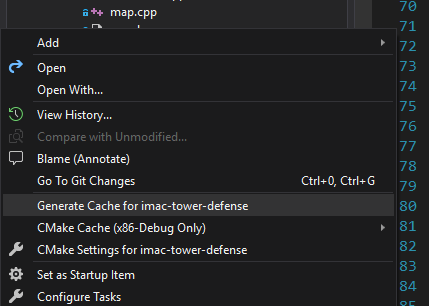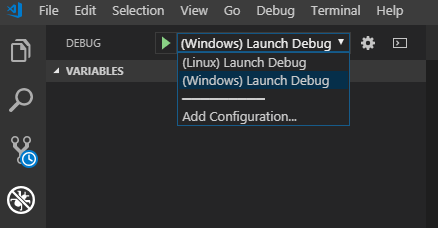guillaume-haerinck / Imac Tower Defense
Programming Languages
Projects that are alternatives of or similar to Imac Tower Defense
Imac Tower Defense
An OpenGL 4.4 game made with Entity-Component-System design pattern.
This is a student project for the French engineering school IMAC. If you're a french-speaker, you might consider to have a look at the post-mortem (it has a lot of images) inside the doc folder.
The structure of this project is being improved in my next C++ game Roll Goal. The main changes are : improved state machine with the pushdown automaton structure, the replacement of most events by singleton components, a render queue for the renderrer and an more elaborate and maintenable structure for rendering (materials, layers, ...).
Table of Contents
Additional info
Features
To-do list
- [x] Integrate ECS system
- [x] Load & play spritesheet
- [x] Load, validate and interpret .itd files
- [x] Load map as a grid
- [x] User interface
- [x] Play audio
- [x] Object picking
- [x] Construction system
- [x] Monster path following
- [x] Attack system
- [x] Projectiles
- [x] Waves system
- [x] Banking system
- [x] Switch levels
- [x] Attack with raycasting
- [x] Mirror towers
- [ ] Level design
- [ ] Tutorials
Getting Started
Prerequisites
You must install CMake and a C++ compiler which handles C++ 14. More on the compiler on the next sections.
The project need your graphic card driver to be up to date, as it is using OpenGL 4.4 core profile (released in 2013, so it should be fine).
Linux
The recommended compiler is g++, minimum version required is g++ 6.1, which is included by default on many linux distribution. You can update it with :
sudo apt-get install build-essential
You will also need the OpenGl and SDL2 packages.
sudo apt-get install libsdl2-dev
sudo apt-get install libglu1-mesa-dev mesa-common-dev
Windows
The recommended compiler is MSVC. To install it you will need Visual Studio (which is not VSCode) and select the C++ development package during installation. The MingW compiler will work as well if you prefer to use it.
Build
The CMakeLists.txt file ensure that the project will work on Linux and Windows platforms.
You can build and launch the project in many different ways, we covered a few of them :
Option 1: Bash (Linux only)
Go to this folder with a terminal, and enter those commands.
cmake .
make
./bin/imac-tower-defense
It means that you are genererating a Makefile, then using it to build the project, and finally running the binaries from the current working directory (needed to find assets).
Option 2: Visual Studio (Windows only)
From Visual Studio 2017, you don't need to generate a visual studio project with cmake. You can simply open visual studio, browse the toolbar to File->Open->Cmake... and select the CMakeLists.txt at the root of this directory. From this point, you have to make sure that you are using a x86 build configuration, and running the imac-tower-defense target. If everything is done, simply press f5 or click on the green arrow at the top.
If you add files, you will need to re-generate the cache for a successfull build. To do so, right click on CMakeLists.txt and use Generate Cache for imac-tower-defense
Option 3: VSCode
You will need the CMakeTools extension from vector-of-bools. If you want to change the source code, I highly recommend using the C/C++ extension from Microsoft and the CMake extension from twxs.
From this point, when you will open the repository folder with VSCode, it will prompt you to configure the projet. You must select a x86 kit, for exemple the Visual Studio Community 2017 - x86 kit. Once the configuration is done, you can compile the project by pressing f7. The .exe file will be outputed in build/Debug folder. You can launch it by pressing f5, but make sure to pick your operating system.
Launch
Before launching the compiled binaries, make sure that the working directory is set to this folder, or the shaders files and images will not be found by the program. If you are unsure about how to do it, just copy the builded files to this folder before launching them. (by default, they will be in the bin/Debug folder).
Documentation
Philosophy
The project follows the Entity Component System design pattern. It has been made possible with the great ENTT library.
Our game is concieved as a state machine, and works like this architecture :
Folder structure
| Folder | Description |
|---|---|
| src | Source code |
main.cpp |
Entry point of the game |
components |
Struct of data for entities |
component-factories |
Creation of complex components |
entity-factories |
Classes used to build entities |
events |
Struct of data defining event types |
graphics |
Wrapper classes for OpenGL objects |
gui |
User interface logic |
logger |
Error and log handlers for the game |
services |
Functionalities needed anywhere, like playing a sound |
systems |
Update the game and the entities based on their components (all the game logic is there) |
| core | Constants, Game state machine and map loading |
game-states |
The different states of the game (title menu, in-level, game over, ...) |
level |
Read .ITD and .PPM files, and construct a graph from them |
| res | Ressources loaded at runtime |
audio |
Musics and sound effects used accross the game |
fonts |
Fonts used accross the game |
gui |
XAML files describing the view for each user interface |
images |
Images and spritesheets used by the game |
levels |
.ITD and .PPM describing the levels of the game |
shaders |
GLSL shaders used by openGL for rendering |
| doc | Documentation |
| lib | Dependencies |
Dependencies
- OpenGL - The graphic API used
- GLM - The opengl maths library
- SDL2 - The library used to create a valid OpenGl context
- ENTT - The ECS framework
- SPDLog - Logging lib
- NeosisGUI - GUI WPF lib for end users
- Imgui - Immediate mode GUI lib for debugging
- Debugbreak - Cross-platform code breakpoint header
- StbImage - Load images
- FMOD - Load and play adaptative audio
- Box2D - 2D Physics library
Useful articles
- Awesome Opengl - A list of useful tools for OpenGl
- Awesome Readme - A list of great readme files
- Pathfinding - Red blob games's article on pathfinding
Inspired by
- tddod - Data oriented tower defense using ENTT library
- Unity tower defense template - Tower defense game made with Unity engine
- Unreal engine tower defense template - Tower defense game made with Unreal Engine
- RayWenderlich TD - Tower defense game made in Objective C
- ENTT Pacman - Pacman game using ENTT library
Authors
-
Jules Fouchy - Processing star
-
Cyrielle Lassarre - Designer of the worlds
-
Guillaume Haerinck - Coding maniac







